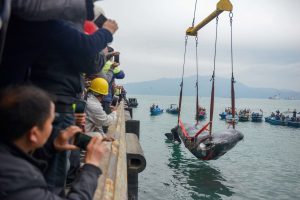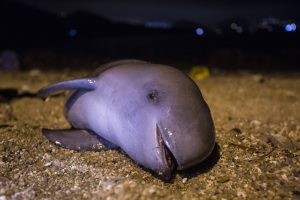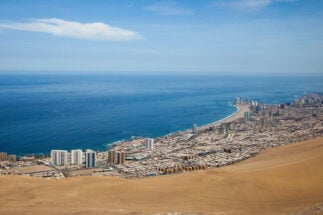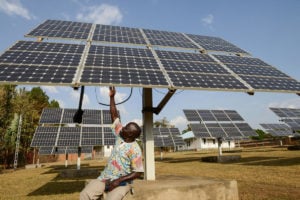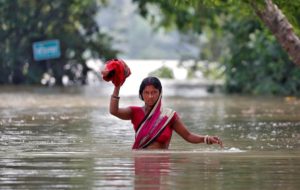In July last year, 12 melon-headed whales were found washed up on a beach in Linhai, Zhejiang province.
The scale of the rescue effort was huge, as was the media attention surrounding it. Oceanariums alone sent 40 people to help. One nearby oceanarium, along with a coastal park and a seafood firm, provided pools to hold the animals temporarily. One particularly weak whale was cared for in an aquaculture pond, with oceanarium staff taking turns to support it. That rescue attempt lasted 22 days, but unfortunately the whale died.
In the end, six whales were saved and released back into ocean. Successful rescues of stranded deep-water cetaceans are rare, according to Zhang Peijun, an associate researcher at the Chinese Academy of Sciences’ Institute of Deep-sea Science and Engineering.
Daren Grover, general manager at Project Jonah, a New Zealand NGO, said that without assistance even a healthy melon-headed whale can only survive for six or seven hours out of water.
Strandings are not uncommon
Cetacean and seal strandings happen fairly frequently around the world. Over 1,000 cetaceans are stranded in the UK every year, according to Rob Deaville of the Cetacean Strandings Investigation Programme at the Zoological Society of London. Meanwhile in the US, 5,764 cetacean, seal and sealion strandings were recorded in 2017, of which 30% were cetaceans. Deaville said that as long as there are cetaceans in the sea, there will be strandings. The real concern would be a lack of such events, as that would indicate “there were none left in the ocean.”
What does “stranded” mean?
A marine mammal is said to be stranded if it is alive on a beach and unable to return to the water, alive on the beach and in need of medical attention, or deceased on the beach or in the shallows, according to the US National Oceanic and Atmospheric Administration.
The book Chinese Cetaceans records 37 different species in Chinese waters, mostly located in the East China and South China seas. There aren’t as many strandings recorded in China as in the UK or US, but they happen. In the three years from 2009 to 2012, cetacean specialist Zheng Ruiqiang alone carried out post-mortems on 60 animals that had died through stranding or injury.
Why do marine animals become stranded?
Cetacean strandings occur when individuals are old, injured, chasing food, lost or disorientated by shipping noise. Understanding why can help us understand the state of the marine environment, and this is what Deaville studies. He said post-mortems of stranded animals find a clear cause in around 40% of cases; those are divided equally between natural causes and manmade causes such as by-catch, collisions and injuries from ships’ propellers. In the remaining 60% of cases, no direct cause is found.
China does not yet have nationwide statistics on strandings of cetaceans or other marine life, so the overall situation is unclear. A paper published in the journal Marine Policy in 2015 listed 97 strandings of marine mammals in Chinese waters between 2000 and 2006, along with 66 incidents of by-catch and 30 injuries. Strandings were most common in Fujian and Zhejiang. The authors also pointed out that the lack of systematic data recording and gathering made analysis and comparison harder, and called for a national network for reporting cetacean strandings.

Zheng Ruiqiang is now science director for marine environment group the ChinaBlue Sustainability Institute. He says better statistics could show where strandings happen and what causes them – allowing for resources to be concentrated in the right places, and manmade causes mitigated. Deaville pointed out that research in the UK identified sea bass pair trawling – two boats towing one large net between them – as a risk to cetaceans, and so in 2004, the government banned the practice within 19km of the coast. There is also strong evidence that climate change is shifting the distribution of strandings in the UK, he added.
The plight of stranded cetaceans
The sad fact is that most stranded animals will die. Andre Silva Barreto, of Brazil’s Universidade do Vale do Itajaí, started collecting stranding data on a number of beaches in 2015. He says animals survived in only 10% of over 7,000 cases.
Unlike other marine animals, cetaceans can breathe air, and so live longer out of the water, providing precious time for rescue. But these creatures usually patrol the deep seas, where the water supports their weight. Whales, in particular, are less likely to survive as their huge bodies press down on their organs.
Unlike orcas, which live near coasts, a melon-headed whale swimming near the shore “is already a problem,” said Daren Grover. “We hope we have the right amount of people [available to help], and these animals are nice and strong and have just taken a wrong turn. But often, there are other reasons why they have stranded. And we may not have the right equipment, and the right number of people at the right time.”
Stranding is a painful process for the animal. Grover explained that the most urgent task isn’t getting the animal back into the water, but to keep it cool and moist, by spraying it with water or covering it up, until it can be returned to the ocean. Overheating is the biggest threat for a stranded cetacean. A whale beached in over 30C summer heat will quickly die.

Funding is also a problem. Sometimes, rescuers can simply return a stranded animal to the water. Care required beforehand increases costs and setting up a rescue operation, with specialised equipment and personnel, isn’t cheap. In China, alongside rescue centres run by oceanariums, there are independent operations in Beijing, Hainan and Guangdong which care for trafficked or injured marine animals. But their rescuers only cover certain areas, and funding and capacities are limited.
Sometimes there is little that can be done for a stranded animal. In certain countries, animals that can’t easily be saved are put down to end their suffering. Jools Farrell, vice president of the Organisation for the Rescue and Research of Cetaceans in Australia (ORRCA), tells rescue volunteers that the biggest challenge is to keep their own emotions under control. “It is distressing to see an animal in distress,” she said. “We are volunteers, we do it because we have a passion for marine mammals. I think you’ve got to control your emotions, because the last thing we need is someone stressing and panicking during a stranding.”
Civil society participation
As in many other countries, China’s rescue system combines government and civil society forces.
According to Wang Yamin, director of the Aquatic Wildlife Conservation Association, the Ministry of Agriculture’s fisheries departments are in charge of aquatic wildlife. In 2010, the ministry announced the formation of a national rescue network for rare and endangered species, made up of fisheries authorities, nature reserves and oceanariums. Wang, who participated in an assessment of Shandong oceanariums, explained that planning for the rescue network had started in 2002. Only oceanariums approved by provincial fishery authorities can take part, he added. The Aquatic Wildlife Conservation Association manages communication between the members of the network and keeps data on rescues.
But far more resources exist along China’s 18,000-kilometre coast than those officially designated part of the national rescue network. One anonymous worker in the field told China Dialogue that in Hainan the network can call upon whale scientists, volunteers, coast guards and even off-duty fishing vessels. Fujian relies primarily on coast guards, working under instructions from fishery authorities.
“Currently, it’s mostly coast guards and volunteers doing the rescues, with scientists providing guidance. There’s no specialist rescue team yet,” said the source.
Wang Yamin thinks dedicated teams are needed. Rescuing different animals requires different knowledge, techniques and equipment. Currently, these are rarely available. He thinks rescues today “lack a little professionalism, and it’s often hard to understand why a rescue succeeded or failed.” He admits setting up those teams will take time and money.
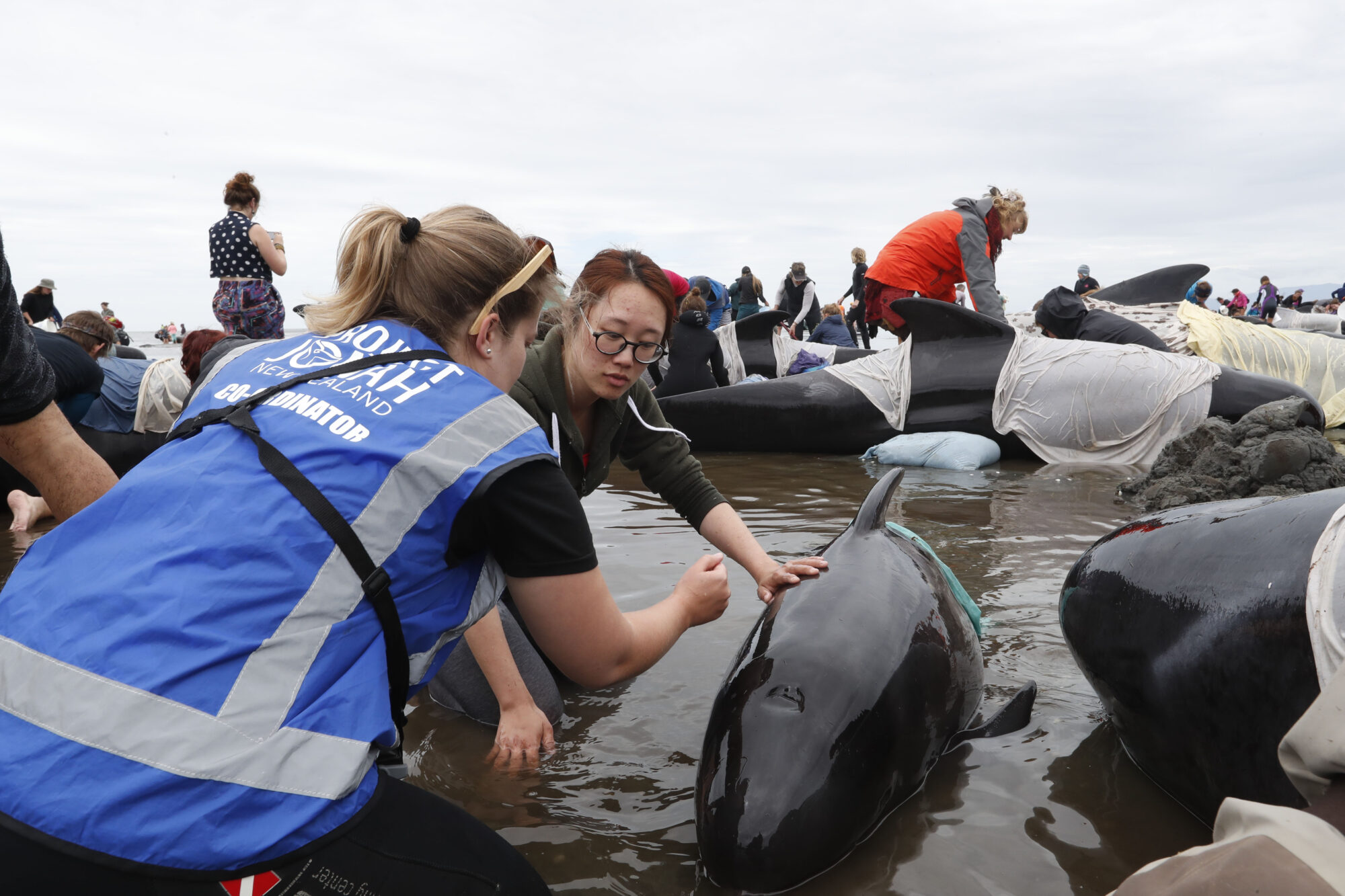
Civil society plays an important role in countries with established rescue networks. In the UK, stranded animals are mostly rescued by one of three civil society networks. In New Zealand, rescues are carried out by Project Jonah, which works with government. In the contiguous United States, which has a coastline around 10% longer than China’s, over 100 groups, mostly research bodies and volunteer groups, form a rescue network, responding to strandings of both live and dead animals. Those networks are staffed mostly by trained volunteers, alongside some veterinarians and scientists.
These animals are all protected species, you could be held liable for any harm.
Zheng Ruiqiang thinks professionals should be first on the scene at rescues, as these can be risky undertakings. Animals can carry diseases or parasites, and there can be legal risks in the case of a failed rescue. “These animals [cetaceans] are all protected species,” he said. “You could be held liable for any harm.” There is no legislation allowing for participation by civil society or even commercial bodies, or, crucially, any waiver of responsibility. He thinks the first thing needed is legal protections for the rescuers.
Another important factor is donations. The fishery authorities provide a certain amount of funding, and oceanariums pay for their own participation as part of their corporate social responsibility programmes. Internationally, it is more usual for specialised rescue organisations to be funded by charitable donations from the public. As Wang Yamin says, rescuing stranded animals costs money. Some of China’s rescue organisations aim to become professional rescue centres – and are looking to public donations to do so.
Zheng Ruiqiang is more interested in first using existing technology to connect China’s networks and make them more effective. An online platform coordinating resources and collecting data could be put together very quickly, he says. Zheng is working on such a system, and it could be up and running soon.
